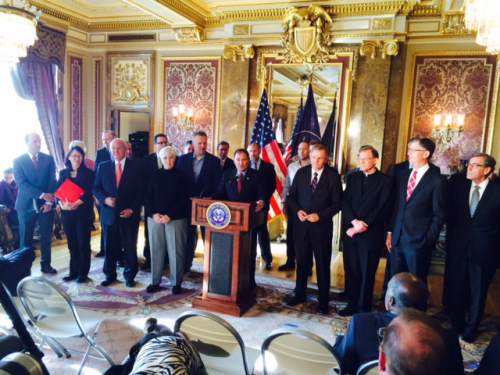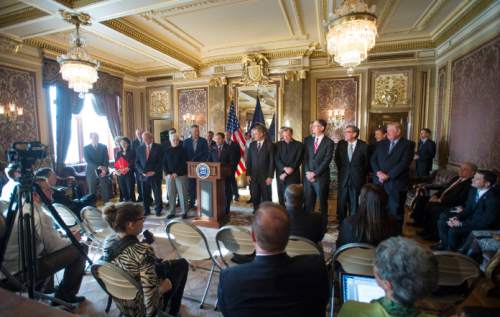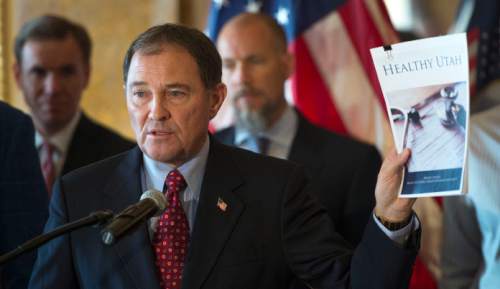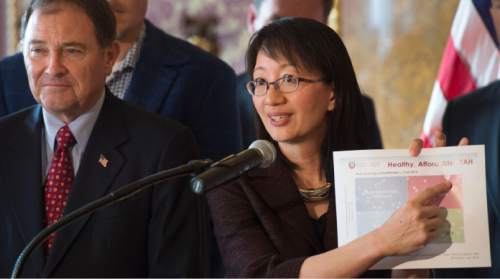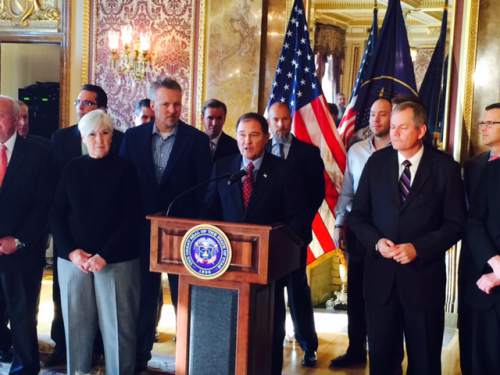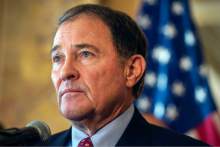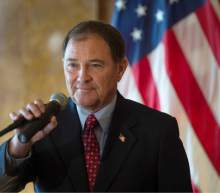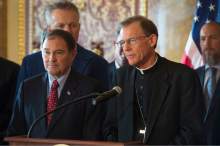This is an archived article that was published on sltrib.com in 2014, and information in the article may be outdated. It is provided only for personal research purposes and may not be reprinted.
Kylie Toponce is just the kind of person that Gov. Gary Herbert's Healthy Utah plan is designed to help: sick but working, too poor to qualify for federal health insurance subsidies, but unable to qualify for Utah's Medicaid program.
But after years of living with undiagnosed stomach troubles and mounting medical bills that forced her into bankruptcy this fall, Toponce, 23, is dubious whether Healthy Utah — unveiled in detail Thursday — or any solution the Utah Legislature devises will help her.
"I don't think there's much hope it will change," says Toponce, who lives in Kaysville and works as a waitress in Roy. "There will always be people like me falling into a bracket who will be screwed."
Herbert, who surrounded himself by a phalanx of medical, insurance, business, religious and charitable leaders at a news conference Thursday, said Utah should provide concrete help in the face of such discouragement.
"These are our neighbors, our friends and our family members," said the governor. "Turning a blind eye and doing nothing is really not the Utah way."
The governor faces a skeptical Legislature, though, especially after he and lawmakers learned this week that any alternative to expanding traditional Medicaid will cost millions more than previously thought.
That's because of a 40 percent increase in the state's estimate of the number of people in the coverage gap who would seek coverage, up to 63,000 from the 45,000 predicted in a 2013 state-commissioned study. A study led by University of Utah economist Norm Waitzman several months ago pegged the number at 77,000.
These are people in the so-called coverage gap, who don't qualify for Medicaid because they don't have children, are not pregnant, disabled or seniors or who have children but earn from 49 percent to 100 percent of the federal poverty level. Those in the gap don't qualify for health insurance subsidies in the federal marketplace.
The Affordable Care Act had envisioned every state would expand Medicaid to cover those people, but the Supreme Court let states opt out of expanding Medicaid, and that created the gap in states like Utah, that did opt out of traditional Medicaid expansion.
Herbert's Healthy Utah plan, negotiated over several months with the U.S. Department of Health and Human Services, would help adults in the gap and those earning up to 138 percent of federal poverty levels buy private health insurance plans.
Those whose employers offer health insurance they can't afford would get wrap-around plans that would help them pay the premiums, co-pays and deductibles of employers' plans.
Herbert's plan goes further than the coverage gap because that brings a much higher match from the feds, starting at 100 percent in 2016 and falling to 90 percent in 2020.
Healthy Utah would be a three-year pilot program. The state's share would rise from $4.6 million for half a budget year in 2016 to $80 million to $90 million per year by early in the 2020s. That's steeply higher than the previous estimates, which had the state saving money for the first few years.
If Utah extends coverage only to those in the gap, HHS will chip in only 70 percent, which is the share they now provide for Utah's Medicaid program.
The Legislature signaled Thursday that the governor's plan won't be the only thing on the agenda when it convenes for the 2015 session on Jan. 26.
"The question of Medicaid expansion isn't just going to be a yes or no to Healthy Utah," said Speaker of the House Greg Hughes, R-Sandy.
Rep. Jim Dunnigan, R-Taylorsville, sketched out four other options to the Legislature's Health Reform Task Force on Thursday. An insurance company owner and House majority leader, he is the co-chairman of the task force.
None of the four would be as generous with low-income people as Healthy Utah, and all would cost millions, he noted. Like Healthy Utah, all the legislative plans would give poor people help paying for private health insurance plans and they'd see similar co-pays, Dunnigan said later.
Option One would help 9,000 medically frail people buy insurance, and would cost the state $21 million in 2016 and $39 million in 2021, Dunnigan said.
Option Two would help 20,000 medically frail people, and would cost $40 million in 2016 and $72 million in 2021.
Option Three would provide help to everyone in the gap, which Dunnigan said is closer to 67,000. It would cost $92 million in 2016 and $155 million five years later.
Option Four would essentially be Healthy Utah — with a sunset provision so the estimated 32,000 people making 101 percent to 138 percent of poverty would be moved back to the federal marketplace for insurance subsidies after the feds stop kicking in as much money. That would cost $5 million the first year, and $88 million in 2020, Dunnigan said. "We'd tell people upfront," he said.
Healthy Utah, he said, would likely cost $93 million by 2021.
"These numbers may change and likely will change," Dunnigan said.
At his press conference, Herbert repeated that he doesn't like the Affordable Care Act, or Obamacare, but noted "It is the law of the land."
He also said Healthy Utah is a way to get back some of the estimated $680 million in new ACA-related taxes the state's companies and taxpayers are sending to Washington.
"We can get money back to Utah and spend it more efficiently and effectively," he said.
The plan has unique aspects that HHS has not allowed any other state, such as co-pays and premiums for those earning above poverty level, and a plan to help poor people get jobs or job training when they sign up for Healthy Utah. President Barack Obama himself said no to making work or job-seeking a requirement of the plan, however, Herbert said.
Lane Beattie, chief executive of the Salt Lake Chamber, called Healthy Utah "the fiscally conservative thing to do," because it brings more money back to Utah.
Vivian Lee, dean of the University of Utah School of Medicine, said Healthy Utah likely will save the state money in the long term because studies show that when people are insured, their health improves.
"It's frankly common sense," she said.
The U. hospital, she said, provided $100 million in care last year for which it was never paid because people lacked insurance.
Bishop John C. Wester, leader of Utah's 300,000 Catholics, said it's unconscionable that low-income people have to go without medical care because they have no insurance and he applauded Healthy Utah. "No human being is expendable," Wester said. "No family is disposable."
Gary Stevenson, the presiding bishop of The Church of Jesus Christ of Latter-day Saints, also attended to support Healthy Utah, but did not speak.
Paul Mero, former president of the Sutherland Institute, stood with Herbert to support Healthy Utah.
"If the private sector doesn't step up, government will and justifiably so because everybody who is impoverished needs to be cared for. That's the soul of a free society," Mero said after the press conference.
His former colleague at the conservative think tank, Derek Monson, however, also attended the news conference because he opposes Healthy Utah. It will push the poorest of the poor, who are already on Medicaid, to the back of the bus for health care, Monson, policy director at Sutherland, predicted.
And, he said, it will cost a bundle. "That money has to come from somewhere. Are we going to take it from schools? Is it going to come from the prison system? Are we going to raise taxes?"
Senate President Wayne Niederhauser, R-Sandy, had much the same question.
"We're looking at the long-term aspects of this policy. What is the governor's Healthy Utah plan going to cost us when the state has to accept their full responsibility, which is 2020? And I think we need to have the discussion now: Where is that money coming from?"
Hughes said the House will rely on its members who are doctors, health care administrators and insurance executives, to tell lawmakers "what we can do right by our constituents, something sustainable so we're not yo-yoing benefits and [which] won't eat away over time from other areas that are critical, like education."
The new speaker, Hughes, replaces, Rep. Rebecca Lockhart, R-Provo, who has long been a critic of Herbert's plan. On Thursday, she likened it to a "smash-and-grab for federal money."
Lockhart did not seek re-election in November.
"It appears the governor got very little if any of the flexibility he originally wanted from CMS [part of HHS] and that doesn't really surprise me," said Lockhart. She scoffed that Herbert's original insistence on a work requirement turned into "a work thought."
Robert Gehrke contributed to this story.
Twitter: @KristenMoulton —
Healthy Utah, Explained
What it is • Gov. Gary Herbert's plan to get health care coverage for tens of thousands of low-income Utahns who fall in the health care coverage gap created when Utah opted out of expanding traditional Medicaid. They don't qualify for the existing Medicaid system, but also don't qualify for subsidized health insurance under the Affordable Care Act (Obamacare).
Who is affected:
Group 1 • Adults without children who aren't pregnant, disabled or seniors and who make less than poverty income ($11,670), and adults (with children) whose income is more than half of the federal poverty level (roughly $9,800 for family of three) but less than poverty level, $19,790. The Utah Department of Health says there are 63,000 such Utahns; the Legislature estimates 67,000.
Group 2 • People who make from 101 percent to 138 percent of federal poverty levels, or $16,105 for an individual or $27,310 for a family of three. The health department estimates 32,000 of these.
How it would work:
People would apply through HealthCare.gov and would be transferred to the Utah Department of Workforce Services if they qualify for Healthy Utah. Or they could start there, at jobs.utah.gov. All would automatically be enrolled in a "work effort" to get jobs, better jobs or job training.
If someone who qualifies for Healthy Utah has an offer of health care insurance through his job, Healthy Utah would help pay for the premiums and co-pays with wrap-around coverage.
Those who don't have insurance through work would get premiums to help pay for private insurance through Utah's health insurance marketplace, Avenue H. Their children, if on Medicaid, could join them on their plans.
Source: Health Utah summary, Utah Department of Health, December 2014.



